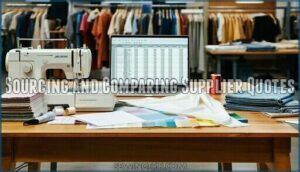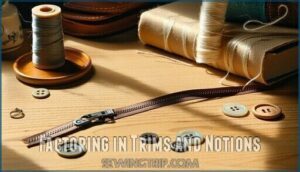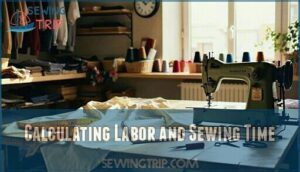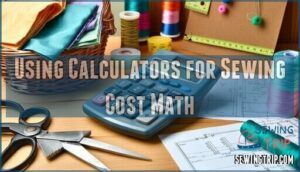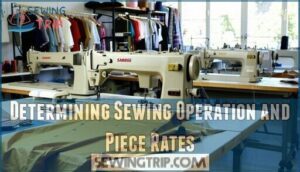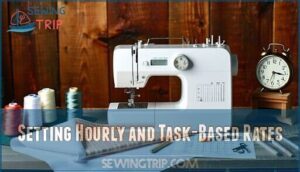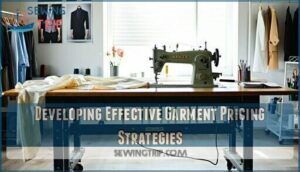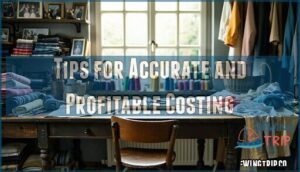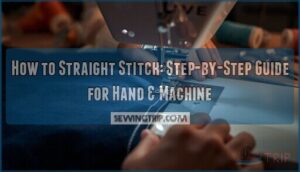This site is supported by our readers. We may earn a commission, at no cost to you, if you purchase through links.
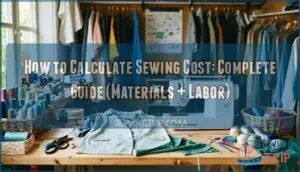
Thread spools, zipper pulls, operator wages, efficiency losses, and overhead expenses compound into numbers that separate profitable sewing businesses from those barely breaking even.
Master the math behind your materials and labor, and you’ll stop leaving money on the cutting table. The formulas that follow turn guesswork into precision, transforming every stitch into a data point you control.
Table Of Contents
- Key Takeaways
- Key Factors Affecting Sewing Cost
- How to Calculate Fabric and Material Costs
- Calculating Labor and Sewing Time
- Using Calculators for Sewing Cost Math
- Determining Sewing Operation and Piece Rates
- Setting Hourly and Task-Based Rates
- Developing Effective Garment Pricing Strategies
- Tips for Accurate and Profitable Costing
- Frequently Asked Questions (FAQs)
- Conclusion
Key Takeaways
- Material expenses consume 60-70% of total garment costs, but fabric is only the starting point—thread, zippers, trims, and notions silently add another 10-15%, making comprehensive Bill of Materials tracking essential to avoid underpricing.
- Standard Allowed Minutes (SAM) multiplied by your rate per minute gives you the exact operation cost per task, but you must adjust for real operator efficiency gaps of 10-30% and build in complexity buffers of 15-50% for specialty work to avoid chronic underpricing.
- Your hourly rate must cover not just desired wages but also rent, utilities, equipment depreciation, administrative overhead, and non-billable hours—then add profit margins on top, or you’re running a hobby that bleeds money instead of a sustainable business.
- Switching between cost-based pricing (expenses plus markup) and value-based pricing (what customers perceive your expertise is worth) determines whether you’re merely covering bills or actually thriving, with luxury segments commanding 60-80% margins versus budget operations surviving on 20-40%.
Key Factors Affecting Sewing Cost
Calculating sewing costs isn’t guesswork—it’s about knowing exactly where your money goes. You need to account for every dollar spent, from raw materials to the time it takes to stitch a seam.
Here are the four cost categories that’ll make or break your pricing accuracy.
Material Expenses
Material expenses don’t just nibble at your profit margins—they devour 60 to 70% of your total garment cost, making them the single most critical factor you need to master before you even thread your first needle.
Fabric costs fluctuate wildly based on textile prices, material sourcing decisions, and supply chain dynamics.
Smart inventory management and strategic pricing through proven garment costing methods give you control over these expenses—because understanding your material costs separates profitable businesses from those drowning in red ink.
Operational and Overhead Costs
Beyond material expenses, your operation still bleeds money through rent, utilities, equipment depreciation, and administrative overhead—costs that won’t show up on your fabric invoice but will absolutely sink your pricing if you ignore them.
Factory rent and utility bills run continuously whether you’re producing one garment or a thousand. Equipment depreciation chips away at your capital investments.
These operational costs directly influence your hourly rate, daily wages, and piece rate calculations—meaning every operation rate you set must account for these hidden expenses or you’re working at a loss.
Labor and Time Considerations
Your labor costs don’t just reflect what you pay your workers—they multiply through efficiency losses, skill gaps, and the brutal reality that complex operations eat minutes you can’t afford to waste.
An operator with poor training drags down your hourly rate ROI, while bottlenecks in productivity analysis expose where your daily wages fund inefficiency instead of output.
Mastering time management and work efficiency transforms labor costs from budget drain to competitive weapon—because every operation rate you calculate hinges on whether your team actually delivers the piece rate performance you’re banking on.
Trims, Accessories, and Packaging
Buttons, zippers, labels, and poly bags might look like afterthoughts on your spreadsheet, but they can silently inflate your unit cost by 5–15% if you’re not tracking every snap and swing tag with the same rigor you apply to fabric yardage.
Trim expenses and accessory pricing demand line-item discipline—because bulk packaging costs, labeling requirements, and shipping fees stack fast when you’re sourcing hundreds of units, turning cheap trims into profit leaks that crush your margins before you’ve even cut fabric.
How to Calculate Fabric and Material Costs
You can’t price a garment if you don’t know what it costs to make. Fabric and materials form the foundation of your cost structure—often accounting for 60 to 70% of total production expenses.
Here’s how you break down those numbers, compare your options, and account for every thread and button that goes into the final piece.
Using a Bill of Materials (BOM)
A Bill of Materials isn’t just a shopping list—it’s your financial blueprint that turns guesswork into precision when calculating fabric and material costs. You’ll itemize every input—from primary fabric yardage to thread spools and interfacing—linking each to Unit Cost and quantity required.
This setup gives you accurate Cost Estimation, makes Material Sourcing across your Supply Chain easier, and feeds Production Planning with real numbers.
When you track Inventory Management through your BOM, you’ll uncover hidden Production Costs and sharpen your Pricing Strategies with confidence.
Sourcing and Comparing Supplier Quotes
Once you’ve assembled your BOM, the real leverage comes from pitting suppliers against each other to uncover the best combination of price, lead time, and reliability. Supplier Research and systematic Quote Analysis turn raw numbers into actionable intelligence:
- Request itemized quotes from at least three vendors for Cost Comparison.
- Scrutinize Wholesale Price tiers and volume discounts that protect Profit Margins.
- Apply Sourcing Strategies that balance quality against total landed cost.
- Document findings in a Vendor Management tracker to fuel Supplier Negotiation and enhance Pricing Strategies over time.
Factoring in Trims and Notions
Zippers, buttons, elastic, thread, and labels may look like budget dust—until you realize they quietly devour 10–15% of your garment cost.
Track every Notion Expense in your BOM: Thread Pricing, Zipper Costs, Button Budget, label fees, and Packaging. A simple table keeps Trim Costs transparent and your Pricing honest.
| Trim Item | Unit Cost |
|---|---|
| Metal zipper | $0.85 |
| Polyester thread (1000 yd) | $2.10 |
| Woven label (100 pcs) | $15.00 |
Calculating Labor and Sewing Time
Labor costs make or break your profit margins, but you can’t price accurately without understanding how time translates into dollars.
Calculating sewing time involves three core elements that determine what you’ll actually pay per garment.
Here’s how to measure labor costs with precision and confidence.
Measuring Standard Allowed Minutes (SAM/SMV)
You can’t price labor accurately until you measure how long each operation actually takes—and that’s where Standard Allowed Minutes (SAM) become your profit-protecting baseline.
Run a time study: watch your skilled operators work through each task—collar attachment, sleeve setting, the whole deal. Use those timings to calculate SAM, then plug that number straight into your operation rate formula.
Now your piece rates and daily wages are tied to actual performance data, not wild estimates.
Determining Operator Efficiency
Even operators with identical SAM targets won’t deliver the same output—efficiency gaps of 10–30% can quietly drain your labor budget if you don’t measure and adjust for them.
Monitor how efficiently each operator works by comparing their actual hourly output against your labor standards—daily production planning and efficiency metrics give you the numbers you need.
Use that data to recalibrate your operation rate and piece rate formulas, ensuring your daily wages reflect real-world performance—not theoretical benchmarks that ignore operator training gaps or quality control slowdowns.
Factoring in Additional Tasks and Complexity
Specialty stitching, intricate embellishments, and unpredictable rework don’t fit neatly into your SAM calculations—yet they can silently inflate labor hours by 20–40% if you treat every garment like a straight seam.
Build complexity buffers into your time estimation by assigning multipliers to non-standard operations:
- Button-hole reinforcement: +15% SAM
- Hand-sewn details: +25–50% SAM
- Quality rework cycles: +10–20% buffer
- Pattern matching: +12% time allocation
- Custom alterations: case-by-case pricing
Track these efficiency metrics to prevent cost overruns and justify your pricing—calculating alteration costs and setting hourly rates demands task prioritization that reflects real complexity, not theoretical piece rate calculation methods that ignore the messy reality of sewing business operations.
Using Calculators for Sewing Cost Math
Your calculator isn’t just for adding up fabric yards—it’s your secret weapon for managing fractions, decimals, and multi-step costing formulas without breaking a sweat.
Mastering a few key functions will save you time and keep your numbers accurate when every cent counts. Here’s how to make your calculator work harder for you.
Entering Fractions and Mixed Numbers
Most calculators process whole-number fractions easily—but mixed numbers like 2 ¾ yards or 5 ⅜ inches demand a three-step approach that prevents costly miscalculations.
First, enter your whole number. Next, hit the fraction space button to signal you’re adding a fractional component. Then input your numerator, click the fraction bar, and finish with the denominator.
This sequence locks in mixed number entry without converting prematurely to improper fractions or triggering decimal conversion errors that throw off your fabric calculations.
Switching Between Fraction and Decimal Formats
After locking in your mixed number, you’ll need to flip between fraction and decimal views to match supplier quotes, verify yardage totals, or reconcile invoices that arrive in different formats.
Most calculators pair a DEC button with a FRA button to toggle instantly:
- Hit DEC when suppliers quote cotton at $3.25 per yard
- Press FRA to verify your ⅝-inch seam allowances align with pattern specs
- Switch back to decimal formats before multiplying unit costs by quantity
This fraction conversion workflow prevents rounding errors that silently inflate your material budget.
Performing Multi-Step Calculations
Real costing power shows up when you chain operations—fabric yards multiplied by per-yard cost, then add thread spools, subtract bulk discounts, and divide the total by units ordered.
Master calculation sequencing by locking each interim result before advancing: your calculator shortcuts preserve decimal precision across every step, letting you toggle to fraction conversion mid-stream without losing accuracy.
Strategic mixed number math and disciplined numerical computation turn complex cost calculation into a repeatable fraction calculation system you can trust.
Determining Sewing Operation and Piece Rates
You can’t price your sewing work fairly without understanding operation and piece rates. These calculations break down exactly what each task costs based on time, wages, and efficiency.
Here’s how to calculate rates that protect your bottom line and keep you competitive.
Operation Rate Formula (SAM × Rate Per Minute)
Multiply your operation’s SAM value by the rate per minute, and you’ll determine the precise cost of every sewing task—no guesswork, just numbers that tell the truth. Here’s how to master this efficiency metric:
- Calculate your rate per minute from hourly rate or minimum daily wage
- Record operation time (SAM) for each specific sewing task
- Apply the formula: Operation Rate = SAM × Rate Per Minute
- Verify your production rates align with labor costs
- Use this cost analysis to justify accurate piece rates
Piece Rate Calculation Steps
Breaking down piece rates into three straightforward steps transforms a complicated pricing puzzle into a repeatable system that protects your profit margins and rewards skilled operators fairly.
First, calculate your operation rate using SAM and hourly rate. Second, determine operator capacity—how many pieces they’ll complete per shift at realistic sewing efficiency levels.
Third, multiply operation rate by expected production volume to establish fair piece rates that cover labor costs while maintaining competitive production pricing.
Adjusting for Minimum Wages and Efficiency
When your calculated piece rate dips below regional minimum wage thresholds or your operator efficiency hovers under 60%, you’re staring at a costing breakdown that demands immediate recalibration—not guesswork.
Bump your operation rates up to meet legal minimums while accounting for Location Factors like regional cost-of-living differences.
Build Efficiency Bonuses into sewing piece rate structures that reward Skill Level improvements, turning Wage Impact concerns into competitive advantages through smarter cost estimation.
Setting Hourly and Task-Based Rates
You can’t build a sustainable sewing business without knowing what to charge. That starts with setting rates that reflect your skill and cover your costs.
Your hourly rate anchors everything, but individual task pricing gives you flexibility for quick jobs and alterations.
Here’s how to calculate both without selling yourself short.
Calculating Your Hourly Rate
Your hourly rate isn’t just a number—it’s the foundation that determines whether you’re running a sustainable business or slowly going broke one zipper at a time.
Here’s how to nail down your rate calculation:
- Track your actual labor costs: Add up rent, utilities, equipment, insurance, and taxes—not just your desired wage
- Factor in non-billable hours: Time tracking reveals you’re not sewing eight straight hours; admin work counts too
- Build in profit margins: Your hourly wage covers survival; profit margins fund growth and those inevitable slow months
- Compare against operation rates: Compare your pricing sewing services against local market data to determine fair compensation without underpricing yourself
Pricing Common Sewing Tasks and Alterations
Once you’ve locked in your hourly rate, the next battlefield is task-by-task pricing—where a simple hem can range from $8 to $30 depending on whether you’re charging like a hobbyist or a professional who knows their worth.
Start by building a pricing list for common tasks—hemming pants, replacing zippers, altering waistbands—then adjust each alteration fee based on fabric costs, labor charges, and complexity.
Research local sewing rates to determine fair compensation without leaving money on the table.
Avoiding Underpricing and Client Exploitation
Underpricing doesn’t just hurt your wallet—it trains clients to see your expertise as disposable, setting a dangerous precedent that’s nearly impossible to reverse once you’ve established it.
Fair pricing requires market research and price transparency—know what competitors charge, then communicate your rates confidently without apology.
Ethical sourcing and proper client communication protect you from exploitation; if someone balks at your fees or demands free revisions, that’s a red flag signaling it’s time to walk away and preserve your professional boundaries.
Developing Effective Garment Pricing Strategies
You’ve crunched the numbers on materials and labor—now it’s time to turn those costs into a price that works. Your pricing strategy determines whether you’re building a sustainable business or leaving money on the table.
Here’s how to position your work in the market and charge what you’re actually worth.
Cost-Based Vs. Value-Based Pricing
Choosing between cost-based and value-based pricing isn’t just splitting hairs—it’s the difference between covering your bills and actually thriving in a competitive market.
Cost-based pricing adds a markup to your material and labor expenses, ensuring you don’t operate at a loss.
Value-based pricing goes after what customers actually believe your work is worth—your skills, how fast you deliver, and those extras that make you different from the shop down the street.
Researching Local Market Rates
To break free from guesswork pricing, you’ll need hard data on what your competitors charge. Regional costs swing wildly—sewing professionals in Nome, Alaska averaged $22.33 per hour in 2025, while the national rate hovered around $18.00.
Scout local tailoring shops, alteration services, and freelance sewers to map your market. This competitive analysis reveals whether you’re operating in a high-wage metro or a budget-conscious region, letting you price strategically without leaving money on the table.
Understanding the tailoring services market is essential for setting competitive prices.
Adjusting for Luxury, Budget, or Value Segments
Market positioning transforms identical production costs into wildly different price tags. Luxury pricing targets status-driven buyers who’ll pay 3x–10x direct costs for exclusivity, while budget strategies squeeze 1.5x–2.5x markups from volume. Your segment analysis determines whether you’re selling prestige or accessibility—and that choice reshapes every costing method.
Strategic cost differentiation demands honest math:
- Luxury garments allocate 60–70% to premium fabrics, with skilled labor adding 25% of the final price through complex construction
- Budget strategies cap material at 38–53% and labor at 10–17%, prioritizing efficiency over embellishment
- Value marketing places your work between extremes, blending quality with competitive wholesale and retail pricing formulas
- Packaging and presentation swing from 3–7% (budget) to 10–20% (luxury), reflecting brand expectations
- Markup discipline separates profit from loss—luxury brands command 60–80% margins, while budget operators survive on 20–40% through relentless turnover
Garment costing methods and pricing strategies for apparel must align with your target customer’s willingness to pay, not just your production expense. Understanding garment pricing is vital for determining the ideal price for your products.
Tips for Accurate and Profitable Costing
You’ve calculated the costs, set your rates, and built a pricing strategy—but the real work starts when you protect those numbers.
Smart costing isn’t a one-time exercise; it’s a living system that adapts as your business grows.
Here’s how to lock in accuracy and keep your margins where they belong.
Building Supplier Relationships for Savings
Working closely with your suppliers opens up cost savings that many manufacturers miss entirely.
Building long-term partnerships can trim 10-14% off wholesale prices—mainly through smarter planning and committing to larger volumes upfront.
You’ll see joint business planning cut administrative costs by 18-22%, directly lowering your Manufacturing expenses and final Retail Price.
Beyond Pricing advantages, these relationships strengthen Risk Management—preferred partners slash emergency sourcing costs by 25%.
Sustainable Sourcing partnerships deliver both ethical compliance and 18% lower lifecycle costs per garment.
Regularly Updating Cost Tables and Quotes
Even strong supplier partnerships crumble if you’re quoting clients with outdated material costs—quarterly price reviews keep your margins accurate and competitive. Implement systematic Cost Tracking to prevent profit erosion:
- Update Unit Cost tables monthly for fabrics, trims, and shipping terms and costs
- Conduct Price Updates analysis comparing supplier quotes against your Costing table examples
- Integrate Quote Management software that flags outdated pricing during Budget Planning
- Run Data Analysis on material variance to identify which costs shift most frequently
By staying on top of costs this way, you shift from scrambling to fix pricing problems to preventing them before they happen.
Documenting Costs for Business Success
Good documentation is what separates sewing businesses that make money from those that lose it on forgotten costs and missed charges.
Set up solid Expense Management systems that track every Unit Cost—thread spools, fabric remnants, overtime hours, all of it.
Your Financial Reporting framework should enable Budget Analysis that reveals true margins, not guesswork. Master Cost Tracking across every project, and you’ll achieve Profit Maximization.
Calculating project costs becomes systematic when documentation drives your Pricing strategy, transforming Sewing business advice into actionable profit.
Frequently Asked Questions (FAQs)
What is the difference between estimated and actual cost per minute?
Picture a factory floor where supervisors project $50 per garment minute, yet actual production cost hits $65—that’s a 30% cost variance crushing your margins.
Estimated cost per minute represents your projected labor efficiency before production begins, based on standard rates and expected operator capacity. Actual cost per minute reflects real sewing operations performance after rate analysis and cost adjustment for delays, rework, or lower labor efficiency.
Calculating project costs requires comparing these minute values to identify production cost discrepancies. Smart pricing depends on tracking both metrics throughout your cost calculation process, ensuring you’re not bleeding profit on every seam.
What are the considerations for handling different styles in a line?
Each style in your line needs its own production plan—one that factors in how complex the design is, what fabrics you’re working with, and the specific sewing steps each piece requires.
Line optimization balances production cost against pricing strategy in garment manufacturing.
How do I calculate the cost of my sewing time?
To calculate your sewing time cost, track minutes spent per task using Time Tracking methods, multiply by your hourly labor rate, then adjust for efficiency metrics.
This Labor Cost Analysis ensures accurate Pricing using a Calculator for precision.
What are some tips for pricing my handmade items competitively?
Competitive Analysis reveals what rivals charge, letting you anchor your Pricing strategically.
Research Customer Segments to identify who values handmade quality—Price Elasticity shows premium buyers tolerate higher Retail Price.
Calculate Cost plus desired Profit Margins, then test Wholesale Price tiers that protect Profit while staying market-relevant.
How to calculate waste and scrap percentages?
You’ll track waste by dividing scrap weight by total material weight, then multiply by Material Optimization and Waste Management demand this Efficiency Metrics calculation.
Your Cost Accounting improves when you price Scrap Reduction into every garment using a Calculator for precise fraction-based Cost calculation.
What profit margin should I include?
Your Profit Margins depend on your positioning—luxury brands command 50–70%, value-focused businesses target 30–50%, and budget manufacturers work within 15–30%.
Market Research reveals what customers will pay, while Cost Analysis ensures profitability isn’t fantasy.
How to estimate fabric shrinkage costs?
Fabric Shrinkage adds to Material Loss through relaxation during pre-washing. Account for shrinkage by purchasing extra yardage—usually 3-10% depending on Fiber Stretch and Weave Density—then update your Fabric Cost and Pricing Calculator accordingly for accurate Sewing budgets.
When should I revise my pricing?
You’re probably thinking, "I’ll just set my prices once and forget about it—what could go wrong?" Turns out, everything.
Revise your Pricing when Cost Inflation hits your materials, Labor rates shift, Profit Margins compress, Market Trends reshape demand, Customer Feedback reveals friction, or Seasonal Demand spikes.
Ignoring these signals means you’re subsidizing your Sewing business instead of profiting from it.
How to calculate setup and changeover time?
Setup Time is the period spent preparing machines, cutting tools, and workstations for a new style or batch.
Track downtime analysis and labor optimization to calculate changeover costs by multiplying preparation hours by your hourly sewing rate, ensuring accurate cost calculation for production efficiency.
Conclusion
A Toronto tailor once tracked her first 50 alterations and discovered she’d underpriced hemming by 40%—leaving $800 on her cutting table in just two months.
She recalculated using SAM rates, updated her supplier quotes, and rebuilt her pricing from actual data rather than guesswork.
Once you know how to calculate sewing cost with precision, every fabric yard and every minute becomes a decision you control, not a surprise that drains your margins.
- https://www.cbi.eu/market-information/apparel/how-calculate-cost-price-apparel-item
- https://www.bls.gov/oes/2023/may/oes516052.htm
- https://www.investmentmonitor.ai/comment/impact-of-increasing-labour-costs-on-apparel-supply-chains/
- https://www.seamwork.com/sustainable-sewing-projects/is-it-cheaper-to-sew-your-own-clothes
- https://www.mh-chine.com/blog/products/fabric-material-price


